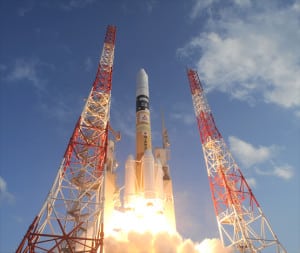MHI Exec Hopes For Great International Presence Going Forward
[Via Satellite 01-13-2016] Mitsubishi Heavy Industries (MH) hopes the successful launch of Telesat’s Telstar 12 Vantage satellite on the H-2A rocket will be the precursor to more international business. Ko Ogasawara, vice president and general manager at MHI Launch Services, told Via Satellite that the company hopes to do more launches for international customers in the 2018 timeframe. MHI is booked pretty solid with Japanese government launches over the next two years.
“In 2016, we will have four to five launches, all government launches. In 2017, there will be another four to five government launches. We would love to have other deals with the ‘Big Four’ operators. We are now doing new launcher development for the H3 vehicle, which will be very competitive to SpaceX and Arianespace. The big operators are very interested in launching with the H3,” he said.
The Telesat launch took place at the Tanegashima Space Center in late November 2015. It was a key event for MHI, given that Telesat is one of the ‘Big Four’ FSS operators. Ogasawara admits MHI aims to bring the cost of its launch services down as it looks to compete better in the market. These plans will be accelerating around 2020 when the company hopes to bring its H3 launch vehicle to market.
“There are many good launch service providers looking to capture market share. We have a number of launches from our government. But launch prices should start to reduce to compete with new launch vehicles such as the Falcon 9 and Ariane 6. So, we will launch new launch vehicles after 2020 such as the H3,” said Ogasawara. “We expect launch prices will go down more than 30 percent. So, we need to have many more launches compared to what we have today. So, we need more launches from the international market. I believe we can do that with the H3.”
The key to MHI’s plans will be the H3 launch vehicle, which will bringer greater flexibility to potential customers. The company hopes to perform the maiden launch for the H3 in 2020. The development of this vehicle started in 2014 in collaboration with The Japan Aerospace Exploration Agency (JAXA) to target both the institutional and commercial markets. The rocket will be able to launch bigger satellites and with better overall technology and reduce costs for customers.
MHI could scale up the number of launches it does a year and this could increase still further if it strikes a chord with commercial customers. Ogasawara admits the company’s future plan for the H3 is for it to be a much more customer-oriented launch vehicle and that the company is hopeful it can gain more orders from commercial customers. After the transition phase from H-2A/B to H3, MHI is scheduled to manufacture eight vehicles per year. “Moreover, if we get enough orders from around the world then we are planning to increase the production capability to up to 10 a year,” he said. “We do about three to four government launches a year, so if we go to 10 then we could potentially do six commercial launches.”
The company wants to be part of the conversation much more for international operators going forward. “From the satellite operators and manufacturers point of view, I believe that more choices of launch service providers will be welcomed and the key for customer is price and reliability. We would like to continue to provide at least one launch for overseas customer per year by 2020, so we have more experience of commercial launch services. Then we would like to have more commercial customers going forward and for the market to rely on us more and more. We strongly hope that we have a gamechanger with the H3 after 2020,” said Ogasawara.
The SmallSat market is also one the company could ultimately target, after the 2020 timeframe. MHI is making considerations in its design of the H3 and is planning to prepare for a clustered launch as an option. “Our exposure to the SmallSat market is increasing. We would like to see that. In our coming H3 launch vehicle, we are planning to have a vehicle that will separate many small satellites at once. So, we could offer a good solution to the SmallSat community. We could offer this in the 2021-2022 timeframe,” commented Ogasawara.
MHI also hopes to be more responsive to the market and ultimately launch satellites quicker for customers. “We can now launch a mission in 18 to 24 months after securing a contract, but we plan to speed up the process to be able to do it in 12 months,” Ogasawara added.
